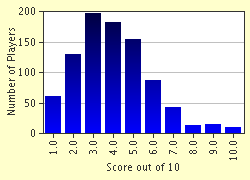Quiz Answer Key and Fun Facts
1. Approximately how many percent of pubescent boys with Klinefelter's Syndrome develop breasts large enough to cause embarrassment?
2. Which was the first enzyme to be crystallized?
3. The medical term for premature aging is what?
4. What is the origin of the name of the Pap test used to detect cervix cancer?
5. In Canavan Disease, when aspartoacyclase is not produced, what compound in the brain cannot be broken down?
6. What is approximately the radioactive half-life of 125-Iodine?
7. This disorder, characterised by severe congenital mental retardation, jerky movements, and a perpetually happy-looking, elfin face, was once known as 'happy puppet' disorder. Name it.
8. The disorder in which the brain lacks gyri (convolutions) is called what?
9. What is the name of the craniosynostosis (premature fusion of cranial sutures) in which the vault is narrow, elongated, and boat-shaped?
10. The term for the collection of disorders in which the bones do not grow or develop properly is called what?
Source: Author
napkintosh
This quiz was reviewed by FunTrivia editor
crisw before going online.
Any errors found in FunTrivia content are routinely corrected through our feedback system.


